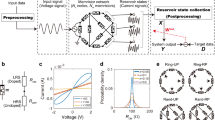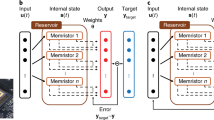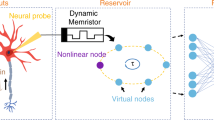Abstract
Memristive devices are of potential use in a range of computing applications. However, many of these devices are based on amorphous materials, where systematic control of the switching dynamics is challenging. Here we report tunable and stable memristors based on an entropy-stabilized oxide. We use single-crystalline (Mg,Co,Ni,Cu,Zn)O films grown on an epitaxial bottom electrode. By adjusting the magnesium composition (XMg = 0.11–0.27) of the entropy-stabilized oxide films, a range of internal time constants (159–278 ns) for the switching process can be obtained. We use the memristors to create a reservoir computing network that classifies time-series input data and show that the reservoir computing system, which has tunable reservoirs, offers better classification accuracy and energy efficiency than previous reservoir system implementations.
This is a preview of subscription content, access via your institution
Access options
Access Nature and 54 other Nature Portfolio journals
Get Nature+, our best-value online-access subscription
$29.99 / 30 days
cancel any time
Subscribe to this journal
Receive 12 digital issues and online access to articles
$119.00 per year
only $9.92 per issue
Buy this article
- Purchase on Springer Link
- Instant access to full article PDF
Prices may be subject to local taxes which are calculated during checkout




Similar content being viewed by others
Data availability
Source data are provided with this paper. Additional data related to this work are available from the corresponding authors upon request.
Code availability
Computational simulation code of the RC system for the speech-recognition task is available from the corresponding authors upon reasonable request.
References
Kumar, S., Wang, X., Strachan, J. P., Yang, Y. & Lu, W. D. Dynamical memristors for higher-complexity neuromorphic computing. Nat. Rev. Mater. 7, 575–591 (2022).
Zidan, M. A. et al. A general memristor-based partial differential equation solver. Nat. Electron 1, 411–420 (2018).
Prezioso, M. et al. Training and operation of an integrated neuromorphic network based on metal-oxide memristors. Nature 521, 61–64 (2015).
Strukov, D. B., Snider, G. S., Stewart, D. R. & Williams, R. S. The missing memristor found. Nature 453, 80–83 (2008).
Zidan, M. A., Strachan, J. P. & Lu, W. D. The future of electronics based on memristive systems. Nat. Electron. 1, 22–29 (2018).
Cai, F. et al. A fully integrated reprogrammable memristor–CMOS system for efficient multiply–accumulate operations. Nat. Electron. 2, 290–299 (2019).
Chen, S. et al. Wafer-scale integration of two-dimensional materials in high-density memristive crossbar arrays for artificial neural networks. Nat. Electron. 3, 638–645 (2020).
Yao, P. et al. Fully hardware-implemented memristor convolutional neural network. Nature 577, 641–646 (2020).
Yin, S. et al. Monolithically integrated RRAM- and CMOS-based in-memory computing optimizations for efficient deep learning. IEEE Micro 39, 54–63 (2019).
Liu, Q. et al. 33.2 A fully integrated analog ReRAM based 78.4TOPS/W compute-in-memory chip with fully parallel MAC computing. In Proc. 2020 IEEE International Solid-State Circuits Conference (eds Fujino, L. C. et al.) 500–502 (IEEE, 2020).
Du, C. et al. Reservoir computing using dynamic memristors for temporal information processing. Nat. Commun. 8, 2204 (2017).
Moon, J. et al. Temporal data classification and forecasting using a memristor-based reservoir computing system. Nat. Electron. 2, 480–487 (2019).
Moon, J., Wu, Y. & Lu, W. D. Hierarchical architectures in reservoir computing systems. Neuromorphic Comput. Eng. 1, 014006 (2021).
Yoo, S. et al. Columnar learning networks for multisensory spatiotemporal learning. Adv. Intell. Syst. 4, 2200179 (2022).
Yoo, S., Lee, E. Y.-J., Wang, Z., Wang, X. & Lu, W. D. RN-Net: reservoir nodes-enabled neuromorphic vision sensing network. Preprint at http://arxiv.org/abs/2303.10770 (2023).
Li, Y., Wang, Z., Midya, R., Xia, Q. & Yang, J. J. Review of memristor devices in neuromorphic computing: materials sciences and device challenges. J. Phys. D 51, 503002 (2018).
Lee, J. & Lu, W. D. On-demand reconfiguration of nanomaterials: when electronics meets ionics. Adv. Mater. 30, 1702770 (2018).
Lee, S. H. et al. Quantitative, dynamic TaOx memristor/resistive random access memory model. ACS Appl. Electron. Mater. 2, 701–709 (2020).
Kim, S. et al. Experimental demonstration of a second-order memristor and its ability to biorealistically implement synaptic plasticity. Nano Lett. 15, 2203–2211 (2015).
Yoo, S., Wu, Y., Park, Y. & Lu, W. D. Tuning resistive switching behavior by controlling internal ionic dynamics for biorealistic implementation of synaptic plasticity. Adv. Electron. Mater. 8, 2101025 (2022).
Kumar, S., Williams, R. S. & Wang, Z. Third-order nanocircuit elements for neuromorphic engineering. Nature 585, 518–523 (2020).
Du, C., Ma, W., Chang, T., Sheridan, P. & Lu, W. D. Biorealistic implementation of synaptic functions with oxide memristors through internal ionic dynamics. Adv. Funct. Mater. 25, 4290–4299 (2015).
Chang, T., Jo, S. & Lu, W. Short-term memory to long-term memory transition in a nanoscale memristor. ACS Nano 5, 7669–7676 (2011).
Rost, C. M. et al. Entropy-stabilized oxides. Nat. Commun. 6, 8485 (2015).
Meisenheimer, P. B. et al. Magneticfrustration control through tunable stereochemically driven disorder in entropy-stabilized oxides. Phys. Rev. Mater. 3, 104420 (2019).
Chae, S., Williams, L., Lee, J., Heron, J. T. & Kioupakis, E. Effects of local compositional and structural disorder on vacancy formation in entropy-stabilized oxides from first-principles. npj Comput. Mater. 8, 95 (2022).
Sze, S. M. & Ng, K. K. Physics of Semiconductor Devices 3rd edn (Wiley, 2007).
Ielmini, D. & Zhang, Y. Analytical model for subthreshold conduction and threshold switching in chalcogenide-based memory devices. J. Appl Phys. 102, 054517 (2007).
Kotsonis, G. N. et al. Property and cation valence engineering in entropy-stabilized oxide thin films. Phys. Rev. Mater. 4, 100401 (2020).
Jacobson, V. et al. The role of co valence in charge transport in the entropy-stabilized oxide (Mg0.2Co0.2Ni0.2Cu0.2Zn0.2)O. J. Am. Ceram. Soc. 106, 1531–1539 (2023).
Schrøder, T. B. & Dyre, J. C. Universality of AC conduction in disordered solids. Rev. Mod. Phys. 72, 873–892 (2000).
Elliott, S. R. A.C. conduction in amorphous chalcogenide and pnictide semiconductors. Adv. Phys. 36, 135–218 (1987).
Lee, J., Lu, W. D. & Kioupakis, E. Electronic and optical properties of oxygen vacancies in amorphous Ta2O5 from first principles. Nanoscale 9, 1120–1127 (2017).
Phillips, J. C. Stretched exponential relaxation in molecular and electronic glasses. Rep. Prog. Phys. 59, 1133–1207 (1996).
Wu, Z. W., Kob, W., Wang, W. & Xu, L. Stretched and compressed exponentials in the relaxation dynamics of a metallic glass-forming melt. Nat. Commun. 9, 5334 (2018).
Scher, H., Shlesinger, M. F. & Bendler, J. T. Time-scale invariance in transport and relaxation. Phys. Today 44, 26–34 (1991).
Park, S.-O., Jeong, H., Park, J., Bae, J. & Choi, S. Experimental demonstration of highly reliable dynamic memristor for artificial neuron and neuromorphic computing. Nat. Commun. 13, 2888 (2022).
Lagorce, X., Orchard, G., Galluppi, F., Shi, B. E. & Benosman, R. B. HOTS: a hierarchy of event-based time-surfaces for pattern recognition. IEEE Trans. Pattern Anal. Mach. Intell. 39, 1346–1359 (2017).
Wu, X., Saxena, V., Zhu, K. & Balagopal, S. A CMOS spiking neuron for brain-inspired neural networks with resistive synapses and in-situ learning. IEEE Trans. Circuits Syst. II 62, 1088–1092 (2015).
Gauthier, D. J., Bollt, E., Griffith, A. & Barbosa, W. A. S. Next generation reservoir computing. Nat. Commun. 12, 5564 (2021).
Becker, S., Ackermann, M., Lapuschkin, S., Müller, K.-R. & Samek, W. Interpreting and explaining deep neural networks for classification of audio signals. J. Frank. Inst. 361, 418–428 (2024).
Lyon, R. A computational model of filtering, detection, and compression in the cochlea. In Proc. IEEE International Conference on Acoustics, Speech, and Signal Processing (eds Dixon, N. R. et al.) 1282–1285 (IEEE, 1982).
Appeltant, L. et al. Information processing using a single dynamical node as complex system. Nat. Commun. 2, 468 (2011).
Lee, D. et al. Various threshold switching devices for integrate and fire neuron applications. Adv. Electron. Mater. 5, 1800866 (2019).
Kresse, G. & Furthmüller, J. Efficiency of ab-initio total energy calculations for metals and semiconductors using a plane-wave basis set. Comput. Mater. Sci. 6, 15–50 (1996).
Anisimov, V. I., Zaanen, J. & Andersen, O. K. Band theory and Mott insulators: Hubbard U instead of Stoner I. Phys. Rev. B 44, 943–954 (1991).
Van De Walle, A. et al. Efficient stochastic generation of special quasirandom structures. CALPHAD 42, 13–18 (2013).
Zhang, J. et al. Long-range antiferromagnetic order in a rocksalt high entropy oxide. Chem. Mater. 31, 3705–3711 (2019).
Paszke, A. et al. PyTorch: an imperative style, high-performance deep learning library. In Proc. Advances in Neural Information Processing Systems (eds Wallach, H. et al.) 8024–8035 (NeurIPS, 2019).
Acknowledgements
This work was supported by the National Science Foundation (NSF) through awards CCF-1900675, ECCS-1915550, NSF CAREER grant no. DMR-1847847 and NSF MRSEC grant no. DMR-2011839, S.C. acknowledges support from Rackham Predoctoral Fellowship. We gratefully acknowledge the Michigan Center for Materials Characterization. We also acknowledge technical support from Lurie Nanofabrication Facility.
Author information
Authors and Affiliations
Contributions
S.Y. and S.C. conceived the idea and designed the experiments. S.C. synthesized the materials and fabricated the devices under J.T.H.’s supervision together with T.C. S.C. performed the TEM, EDS and material characterizations with T.M., H.P., K.N. and H.G.X. S.C. performed the DFT calculation with L.W. under E.K.’s supervision. S.Y. performed the pulse measurements and analysis with Y.P. and demonstrated the RC systems under W.D.L.’s supervision. S.Y. and S.C. wrote the paper under the supervision of W.L. and J.T.H. All authors contributed to the discussion and checked the paper.
Corresponding authors
Ethics declarations
Competing interests
The authors declare no competing interests.
Peer review
Peer review information
Nature Electronics thanks Shriram Ramanathan, Cristina Rost and Ilia Valov for their contribution to the peer review of this work.
Additional information
Publisher’s note Springer Nature remains neutral with regard to jurisdictional claims in published maps and institutional affiliations.
Supplementary information
Supplementary Information
Supplementary Figs. 1–15.
Source data
Source Data Fig. 1
Unprocessed X-ray diffraction data and simulated structure data.
Source Data Fig. 2
Statistical source data in Fig. 2 and analysis data.
Source Data Fig. 3
Statistical source data and experimental data.
Source Data Fig. 4
Experimental data used in a computational simulation.
Rights and permissions
Springer Nature or its licensor (e.g. a society or other partner) holds exclusive rights to this article under a publishing agreement with the author(s) or other rightsholder(s); author self-archiving of the accepted manuscript version of this article is solely governed by the terms of such publishing agreement and applicable law.
About this article
Cite this article
Yoo, S., Chae, S., Chiang, T. et al. Efficient data processing using tunable entropy-stabilized oxide memristors. Nat Electron (2024). https://doi.org/10.1038/s41928-024-01169-1
Received:
Accepted:
Published:
DOI: https://doi.org/10.1038/s41928-024-01169-1



